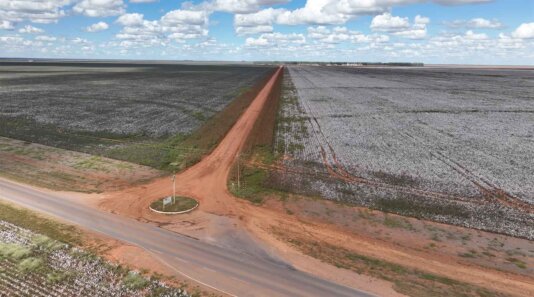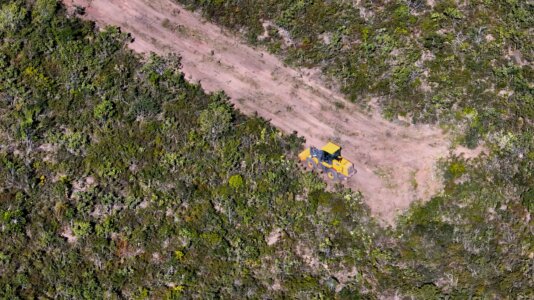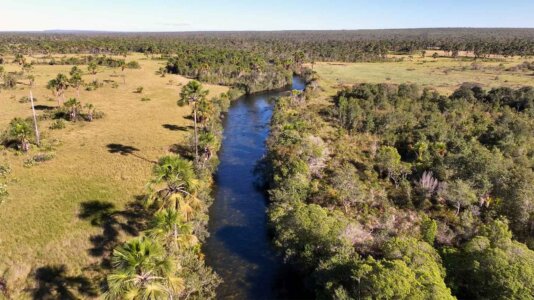- About
- Topics
- Story
- In-Depth
- Picks
- Opinion
- News
- Donate
- Signup for our newsletterOur Editors' Best Picks.Send
Read, Debate: Engage.
| May 04, 2024 | |
|---|---|
| topic: | Deforestation |
| tags: | #fast fashion, #Brazil, #deforestation, #Sustainable Agriculture |
| located: | Brazil |
| by: | Ellen Nemitz |
The fashion industry has been under increasing pressure to adopt more sustainable practices, with the volume of clothes produced, purchased, and discarded threatening the environment. And if the final destination of a new piece of clothing wasn't a problem enough, the cotton used to manufacture it might also be dirty.
An investigation conducted by the UK NGO Earthsight between January 2023 and March 2024 showed that some of the cotton produced in Brazil could be linked to illegal deforestation on the Cerrado biome - home to several species and also known as the "Brazilian water tank" for containing numerous springs and playing a crucial role in recharging water resources, land grabbing and violence against traditional communities.
In investigating the "Fashion Crimes" report, Earthsight spent over a year and a half analysing satellite images, court rulings and shipment records. The team went undercover to conduct interviews and investigations both in Europe and in the northeastern state of Bahia, discovering that eight Asian firms bought at least 816,000 tonnes of Brazilian tainted cotton to make nearly 250 million items of finished clothing and homeware for global stores of H&M, Zara and its related brands.
The report, globally released on 11 April 2024, notes that this demand pressures deforestation in Cerrado, which has risen by 43 per cent in the last year, and that the two main farm companies involved, SLC Agrícola and Horita Group, have a long history of illegal deforestation.
In an interview with FairPlanet, Daniel Ferreira, the acting head of Brazilian Agricultural Research Corporation (Embrapa Cotton), a national research institution established in the 1970s to develop the technological foundation for agriculture and animal farming in Brazil, said Brazil is the fourth-largest cotton producer in the world, behind the US, India and China, contributing over 10 million tonnes of cotton to the market. He added that Brazil is also the second-largest cotton exporter, expecting the country to surpass the EUA and be number one in this global market within a decade.
According to Ferreira, the current area of cotton production is 1,935,000 hectares, and it may expand in the coming years. This is because cotton can be grown in the same fields as soy and corn using a rotation system. In areas where other crops cannot grow, farmers can cultivate soy or corn and then follow it with cotton. This helps to optimise the use of land that may have been deforested before. After the cotton harvest, the cycle begins again with another round of food cultivation.
Because there is usually no land exclusively dedicated to cotton, the damage caused by it in Cerrado can be hidden, explained Rubens Carvalho, Earthsight Deputy Director: “When we talk about the impact of soybean on the Cerrado, it's hard to ignore the impact that cotton also has, [because] many of these companies involved in deforestation and land grabbing also produce large volumes of cotton."
Deforestation is blamed on soy or corn, said Carvalho, but cotton, which is also produced there, is not linked to the original problem.
The Brazilian Association of Cotton Producers (Abrapa) denies that cotton could be responsible for accelerating deforestation in Cerrado using exactly this excuse. I’m an interview with FairPlanet, Abrapa’s executive director, Marcio Portocarrero, said, "It is unfeasible to plant cotton on recently cleared land due to the characteristics of the Brazilian Cerrado, which has soil that is naturally poor in nutrients and very acidic," a condition that requires the aforementioned rotation system.
"Brazil is the second-largest exporter of cotton, and this position would not be possible in the event of irregularities such as illegal deforestation and pressure on indigenous communities. The global market is increasingly aware and demanding and will not tolerate this kind of behaviour," he claimed.
"The concern comes from the producer himself, given the Responsible Brazilian Cotton (ABR) programme, an acronym that is becoming better known around the world every day, given the seriousness and complexity of its scope."
Cotton can be grown on a small-scale basis, usually free of pesticides, and many families and farmers are running such businesses in Brazil. However, considering that it is a lower-productivity model, the price of the cotton is typically higher.
"Organic producers do not compete with large producers. There are two distinct markets: one aimed at the mass market (large producers) and one aimed at buyers who strongly believe in organic as a consumer option and are willing to pay more for the product (organic producers). For organic cotton production to increase, the consumer market would have to accept paying a higher price for organic cotton," Embrapa’s Daniel Ferreira explained.
Portocarrero echoed that large-scale production requires a high investment, including machinery and pesticides. "If it is expensive to produce cotton in a modern and efficient way anywhere in the world, the challenge is even greater in Brazil because we are a tropical country. We are a greenhouse, which is very good for the development of everything living, both plants and plagues," he said.
"[We have to] fight the enemies, and we do this through good agronomic practices that make up Integrated Pest and Disease Management (IPM), which includes chemical pesticides, cultural treatments, biological products, etc."
On the one hand, the association claims that chemicals are the only way to combat some plagues, such as bollworms, making large-scale production feasible.
Earthsight’s Carvalho said there are two main paths to addressing the situation and helping tackle the problem: through public policies, that is, governments investing more in combating legal and illegal deforestation, as well as other threats to people and the environment, and also through conscientious consumption.
"The responsibility of the companies that buy these raw materials, and this includes the retailers who sell the finished products in Europe, is to monitor the supply chains and make sure that the raw materials they use in their products are not linked to illegal deforestation, land grabbing, human rights violations, violence or corruption," he said, emphasising that meanwhile, the Brazilian federal government should "stop prioritising the expansion of agribusiness over environmental balance and human rights and find ways to balance them."
Embrapa's representative, Ferreira, opines that cotton is better than polyester, "a synthetic fibre that generates microplastics and greenhouse gases."
Carvalho emphasised an actual better option would be to rethink fashion consumption. "H&M and Zara are companies that launch dozens of new collections a year, with a new collection entering the market every few weeks," he said.
"Their business model is very much based on expanding consumption, with increasingly disposable products. These current production and consumption models need to be rethought and replaced by more sustainable models that don't require this constant expansion of productive areas at the expense of native biomes in Brazil and other countries."
On 23 April, Better Cotton published a statement responding to the Earthsight report. It mentions an independent audit produced by the firm Peterson, which it said confirmed "three out of the farms mentioned were licensed to sell Better Cotton during the time frames specified in Earthsight’s report," but defended that "these three farms were not in breach of the Better Cotton Standard."
The report denies accusations regarding the impacts on local communities, deforestation, and land rights violations, alleging that Brazilian federal bodies had registered and certified its properties. Though Better Cotton admits to being fined before working with the implicated farms, it refutes the allegation that it uses illegal pesticides.
The document reads: "The auditor’s report says that the ABR [Responsible Brazilian Cotton] standard should evolve to become more focused on issues such as community needs and cultural values of lands and to ensure that land conversion does not occur in areas of High Conservation Value.
"In addition, the report finds that the ABR criteria should be strengthened to ensure that producers are not engaged in acts of corruption […] Better Cotton has a due diligence process to review the criteria and procedures used by each of its benchmark partners in the countries where it works with a local association."
The company commits to having full traceability by 2025 in the report.
In a statement published in response to Better Cotton’s report, Earthsight maintains the investigation led by the audit company is "unsatisfactory and incomplete," calling it "flawed as to be almost worthless." Besides clarifying misunderstandings, the NGO claimed that the audit analysed a tiny portion of the farms initially investigated and "ignored the complexities of the issues we uncovered."
Finally, Earthsight highlights that the pledged due diligence and full traceability are welcome improvements, asking, "Is this a reaction to our investigation?"
Image by Earthsight.
By copying the embed code below, you agree to adhere to our republishing guidelines.



